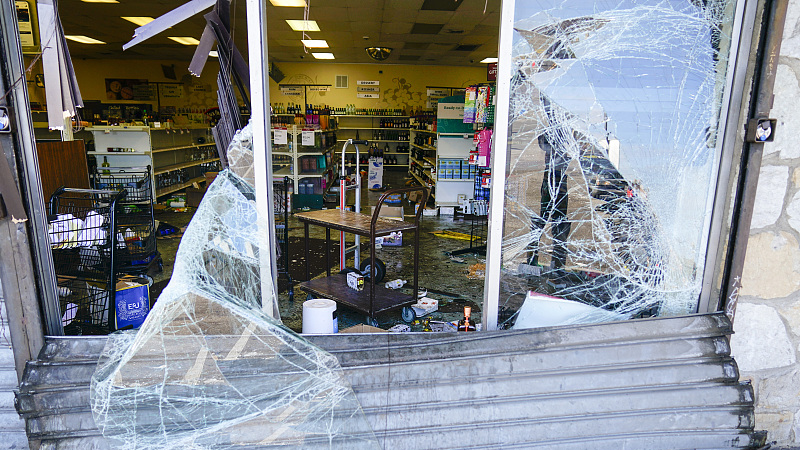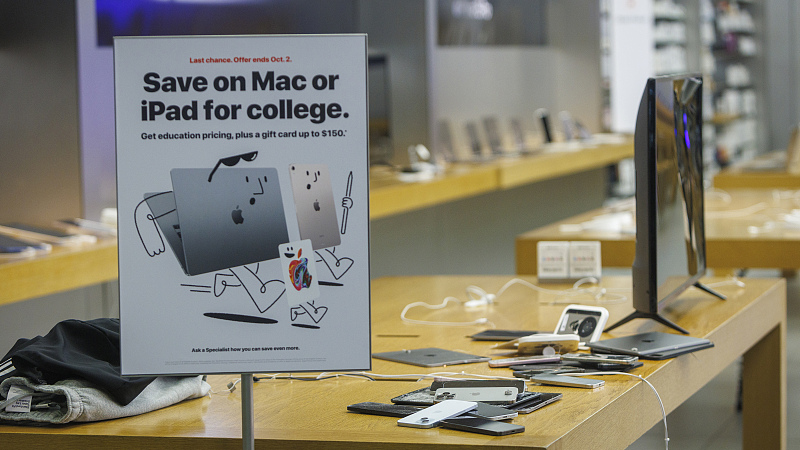
The aftermath of a ransacked liquor store in Philadelphia, Sept. 27, 2023. /CFP
The aftermath of a ransacked liquor store in Philadelphia, Sept. 27, 2023. /CFP
At least 70 people have been arrested after a night of social-media-fueled mayhem a week ago, in which groups of young people stormed businesses in downtown Philadelphia, a city in the U.S. state of Pennsylvania.
After smashing their way into stores, the horde swept and bagged valuable merchandise before fleeing the scene, according to local authorities. An Apple store, a sporting goods store, a GameStop, a medical marijuana dispensary and several liquor stores were among the places ransacked.
Similar incidents have occurred across large cities in the country in recent months. On many occasions, bands of looters masked in hoodies smashed into retail stores in broad daylight before stuffing plastic bags with iPhones and Air Jordans as helpless employees stood and watched.
The chaos in Philadelphia was reminiscent of similarly brazen smash-and-grab thefts elsewhere, particularly in Los Angeles and the Bay Area in California, where organized groups of thieves carrying crowbars and hammers systematically targeted luxury stores.
One of the most immediate and tangible consequences of the smash-and-grab robberies is the economic toll they exact on businesses. Already struggling in the wake of the COVID-19 pandemic, retailers have been hit hard by the incidents.
On September 25, the U.S. National Retail Federation (NRF) warned of the rise in organized crime against stores. It reported that financial losses associated with theft reached a record high of $112 billion last year, up from $93.9 billion in 2021.
"Q2 profitability was short of our expectations due in large part to the impact of elevated inventory shrink, an increasingly serious issue impacting many retailers," said Lauren Hobart, the CEO of Dick's Sporting Goods, on their second-quarter earnings call.
Hobart attributed the losses to "organized retail crime and theft in general," which has become an "increasingly serious issue impacting many retailers."
"The number of incidents and the organized retail crime impact came in significantly higher than we anticipated," said Navdeep Gupta, the CFO of Dick's Sporting Goods, which has more than 850 stores throughout the U.S. and an annual turnover of more than $12 billion.

iPhones lie on the counter of a damaged Apple store in Philadelphia on Wednesday morning, September 27, 2023. /CFP
iPhones lie on the counter of a damaged Apple store in Philadelphia on Wednesday morning, September 27, 2023. /CFP
On an earnings call in August, CEO Brian Cornell of Target – one of America's biggest retailers – warned that the company continues to face an "unacceptable amount" of retail theft and organized retail crime.
"And unfortunately, safety incidents associated with theft are moving in the wrong direction," he said.
According to Cornell, during the first five months of 2023, Target stores saw a 120 percent increase in theft involving violence or threats of violence.
The surge in smash-and-grab robberies has not occurred in a vacuum. Several political factors contribute to this alarming trend.
One of the key factors cited by experts is the ongoing debate surrounding police funding and criminal justice reform. Some cities have seen reductions in police budgets, fewer officers on patrol and changes in law enforcement strategies in response to calls for police reform.
California has seen an increase in property crimes, including robbery, in recent years. Critics point to this trend as evidence that the state's criminal justice reforms may have encouraged criminal behavior. They argue that the perception of lighter consequences for theft-related crimes has led to a surge in such offenses.
The law often cited by Republicans to prove the point is Proposition 47. Approved by voters in 2014, this measure reclassified some nonviolent offenses, including thefts of property valued under $950, from felonies to misdemeanors. It also allowed for the resentencing of some individuals previously convicted of such crimes.
Conservatives argue that the reforms have created a climate where criminals feel emboldened to commit theft-related offenses with reduced fear of serious consequences. Meanwhile, proponents of the reforms contend that the rise in property crimes is part of a broader national trend and is not solely attributable to the changes in California's laws. They argue that the focus should be addressing the root causes of criminal behavior, such as poverty and substance abuse, rather than increasing penalties.
"Political officials are abandoning Americans in this crisis-level shoplifting streak," observed political activist Gabriel Nadales in an article published in The Hill last week.
"It's long past time for lawmakers to reengage and actively address the problem holistically by reexamining budget priorities, directing funding at police forces and removing prosecutors who are unwilling to do their jobs."